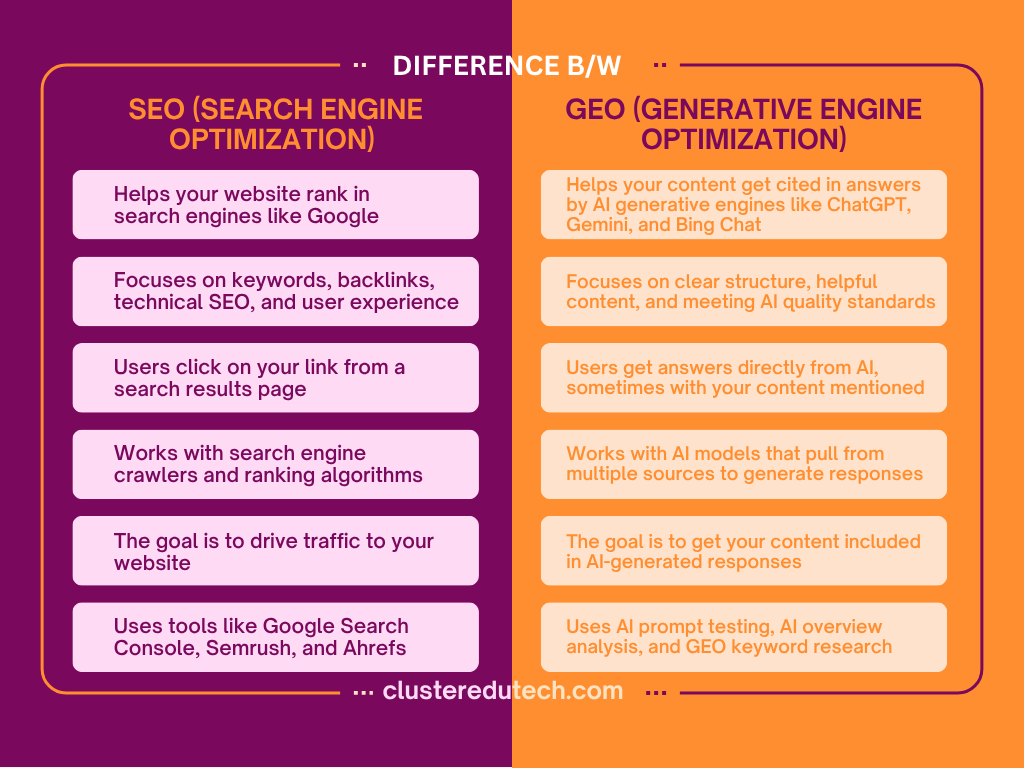What Is Generative Engine Optimization (GEO) and Why Does It Matter in 2025?
July 6, 2025
Share this post
We all know how important SEO has been over the years. Now, there is something new coming up called Generative Engine Optimization. People also call it GEO.
We already have SEO, so why do we need GEO?
The simple reason is this. The way people search for answers or solutions is changing. They are using AI models to get answers quickly.
Tools like ChatGPT, Google AI Overviews, and other platforms are no longer just showing links. They are giving direct responses. That means our content needs to show up in those answers, too.
If you work in digital marketing or content writing, or even if you are just curious, GEO is something you should not miss.
This article will help you learn what is Generative Engine Optimization (GEO) and why it matters in 2025.
In this article, I will explain:
- What is Generative Engine
- What Is Generative Engine Optimization (GEO)
- How does GEO work?
- How to Optimize Content for Generative Engines
- Difference between SEO and GEO
- Conclusion
Read till the end.
What is a Generative Engine?

A generative engine is an AI-powered system designed to handle queries by collecting and generating information from the best and trusted sources. It’s designed to understand natural language, grasp user intent, and provide relevant, human-like answers based on a wealth of data or curated knowledge.
These engines do not just fetch data. They generate it. That is why they feel more conversational and human-like. We can chat with them, ask for summaries, ideas, explanations, or help with tasks. And they respond instantly.
Some Popular Generative Engines:
- ChatGPT
- Gemini (formerly Bard)
- Bing Chat
- Google SGE (Search Generative Experience)
What Is Generative Engine Optimization (GEO)?
Generative Engine Optimization, or GEO, is a new way of doing SEO. Instead of only focusing on Google, GEO is about getting your content found by AI tools like ChatGPT, Gemini, and others.
These AI-powered generative engines don’t just show links. They read your content, understand it, and give answers. GEO helps you create content that these tools can read, trust, and mention.
It’s like writing quality and authoritative content for both people and smart AI systems.
Let’s say someone asks ChatGPT, “What are the best tools for small business marketing?”
If your content is effectively optimized for GEO, it stands a better chance of being mentioned by the AI when it generates answers from your brand, blog, or product.
How does GEO work?
GEO starts with writing content that answers real questions. It’s not just about using keywords. It’s about giving useful, clear, and direct answers.
Next, the content should be easy for AI engines to understand. That means using proper headings, simple language, and a clean structure.
AI engines like ChatGPT or Gemini scan content from many sources. They choose answers that are clear, trusted, and well-explained.
If your content follows this style, there’s a higher chance it will get picked. The AI might then quote your content or include it in its reply.
So, GEO works by helping AI engines find your content, understand it, and use it when someone asks a related question.
How to Optimize Content for Generative Engines?
Getting started with Generative Engine Optimization strategies means first understanding the basics. Your first task should be to tailor your content for AI-powered generative engines by following these five crucial steps:
- GEO Keyword Research
- AI Overview Analysis
- Meet Google’s E-E-A-T Standards
- Content Structure
- Technical SEO
GEO Keyword Research
Whether you’re dealing with a search engine, an AI engine, or a generative engine, the initial step is always keyword research. You have to get a handle on how people search and what they’re seeking.
Start by knowing your audience. Think about their intent. What questions are they asking? What exact words are they typing or speaking?
Focus on the questions users ask
In GEO, long-tail and conversational keywords matter the most. These are real, everyday questions like
- “how to run Facebook ads for a local business”
- “best email marketing tools for beginners”
These queries are natural and more specific. That’s what AI engines prefer.
Use related terms and variations
Don’t use the same keyword repeatedly. Use related words that help AI understand the topic better. For example, if your topic is about SEO tools, also mention:
- keyword tracking
- technical SEO
- Google Search Console
These related words give more context to your content.
Include real-world entities
AI engines use known names and concepts to figure out what your page is about. These are called “entities.” They can be:
- Tools (like Ahrefs, Google Ads)
- Platforms (like Shopify, YouTube)
- Concepts (like backlink strategy, E-E-A-T)
Use them naturally in your writing.
Add context with natural phrases
Don’t stuff keywords. Write like you talk. Add common phrases that match the topic. For example:
- “Grow your small business”
- “Get more traffic from Google”
- “Reach the right audience with ads.”
These help AI engines understand the full meaning behind your content.
Use tools to research better
You can start by checking what comes up in Google’s “People Also Ask” section. Try typing your topic slowly and see what autocomplete shows. These are real things people are searching for.
If you want more ideas, tools like AnswerThePublic and AlsoAsked can give you plenty of question-based keywords. They’re easy to use and show you how people frame their doubts.
You can even try asking ChatGPT a few questions around your topic. Look at how it replies. This gives you a feel for the kind of language and structure that works well with AI systems.
GEO keyword research is not about finding high-volume keywords. It’s about understanding how people think, speak, and search — and aligning your content with that.
AI Overview Analysis
Before we learn how to optimize for AI Overviews, let’s understand what they are.
AI Overviews are short, AI-generated summaries that appear at the top of Google search results. They are designed to answer your query quickly without needing to click through multiple links.
Google introduced AI Overviews as part of an experiment in Search Labs, called Search Generative Experience (SGE). This started in May 2024. While Google has reduced how often these overviews appear, they’re still being shown in many searches, and this may grow over time.
These overviews don’t work alone. They pull information by connecting with Google’s Knowledge Graph and other ranking systems. So, the AI-generated response is not random. It’s based on trusted sources and structured data.
You’ll see an AI Overview only when Google thinks it will be helpful. Right now, they appear in a limited number of searches. But as Google improves the system, we may see them more often.
Now, how do you actually help your content show up in AI Overviews?
Start by thinking about the person behind the search. What are they looking for? Try to answer that clearly and directly. Try adding that answer at the beginning of your page. It helps both people and AI find it quickly.
Keep things simple. Use headings and short sections. Break big ideas into smaller parts. That way, both people and AI can follow your content without getting lost.
And always make sure what you’re saying is correct. Don’t just add words — add value. If there’s a helpful source, link to it. That builds trust.
Add schema markup where it makes sense. This helps Google systems understand your content better.
It’s not just about AI Overviews
Also, keep in mind that AI Overviews are just one piece of the bigger search system. You still have to get the basics of SEO right if you want your content to show up there.
Make sure your website loads fast. Check that it works well on mobile. And focus on giving people real value through your content.
When you combine SEO and good user experience (UX), you create content that works for both people and AI.
That’s how you improve your chances of getting picked by AI Overviews.
Meet Google’s E-E-A-T Standards
To get picked by AI tools like ChatGPT or even Google’s systems, your content has to look trustworthy. This is where something called E-E-A-T from Google becomes important.
It stands for experience, expertise, authoritativeness, and trust. Google looks at these to see if your content can be trusted and is actually helpful.
Let me walk you through what each one stands for in a clear and simple way.
Experience
If you’ve done it yourself, just say what you did. Talk about what worked, what didn’t, or even a small thing you noticed. Real experiences speak louder than general tips.
Expertise
You don’t need to be a big brand. But you should know your topic well. Use simple language, but write like someone who understands the subject clearly.
Authoritativeness
Make sure your content is written or reviewed by someone known in the field. Add an author bio or link to your profile. This helps build your online presence over time.
Trust
Your site should feel safe and honest. Avoid clickbait. Be transparent. Add contact info, clear policies, and sources wherever needed.
If you apply these four things in your content, AI engines are more likely to treat your page as a reliable source.
And when that happens, your chances of getting mentioned in AI Overviews improve.
Content Structure
Good structure makes your content easier to read and easier for AI tools to process.
Begin with proper headings. Use one H1 for the main title. Break the rest of the content into H2 and H3 tags based on the flow. This creates a clear order and helps AI know what each section is about.
Stick to short paragraphs. Group related points together. If something can be listed, use bullet points or numbers. It saves space and makes key details stand out.
Visuals also help. Add images wherever they add meaning. Add alt text to every image by describing what the image is about.
It’s important to ensure your content is top-notch and well-organized. This way, generative engines can easily identify it and present it to those seeking reliable answers.
Technical SEO
You might have good content, but if something’s off with your site, it can still go unseen.
Start by checking how fast your site loads. If your site loads slowly, most people won’t wait around. AI systems will also ignore it.
Make sure your site works well on mobile. Many people search from their phones. AI engines notice if the page is easy to use on smaller screens.
Fix broken links and missing pages. These small things affect how your site is crawled and ranked.
Use proper meta titles and descriptions. This helps both search engines and AI know what your page is about before even opening it.
Add schema markup where needed. It gives extra details about your content and helps AI engines pull the right information.
Technical SEO isn’t just for developers. If the basics are in place, it can really boost how your content performs in AI and search results.
Difference Between SEO and GEO

Conclusion
More of us are turning to AI tools for quick answers. If we want our content to stay visible, we need to create it in a way that these generative engines can understand and share.
GEO isn’t here to replace SEO. It’s here to work with it. And now’s the right time to start learning and applying it.


